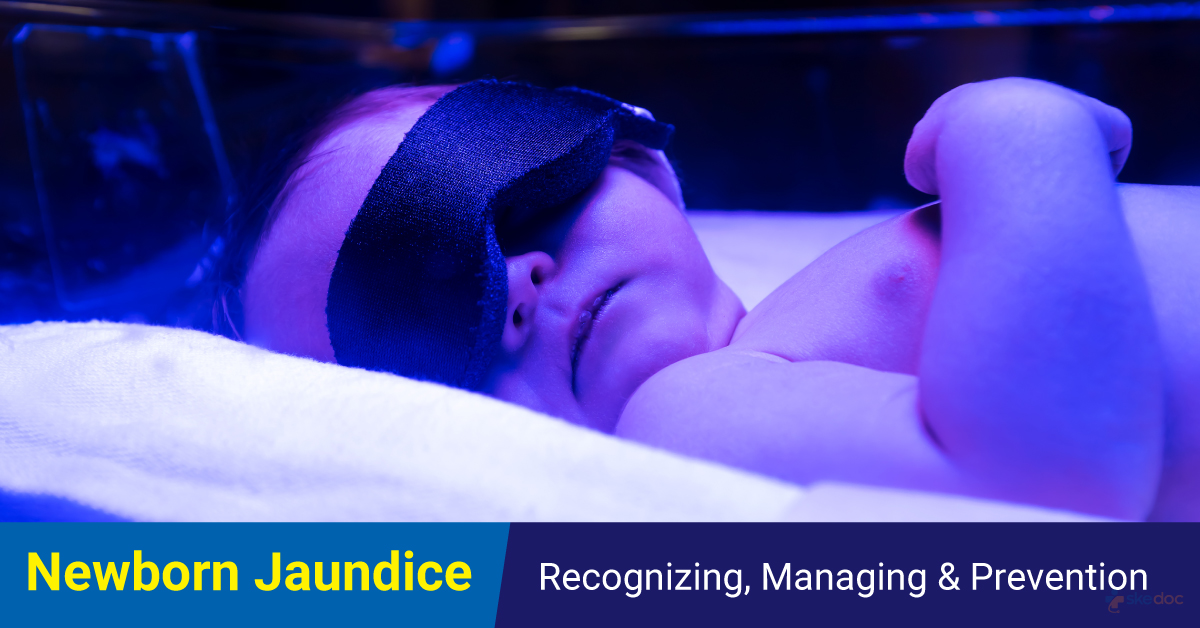Allergy
Blood Diseases
Bone & Joints
Brain
Cancer
Child Care
Cosmetic Surgery
Diabetes
Endocrinology
ENT
Eye
Gen Medicine
General Surgery
Heart
Kidney
Lifestyle
Liver & Digestive
Lung
Men’s Health
Mental health
Physiotherapy
Rheumatology
Skin and hair
Sleep Disorders
Spine
Transplant
Women Health
Thyroid
Vascular Surgery
Newborn Jaundice: Recognizing, Managing and Prevention

Seeing your baby have yellowish eyes and skin can easily make you worried, especially if you are a new parent.
Are you concerned about your newborn having jaundice? Don panic! It's quite common for babies to have jaundice a few days after their birth.
If your baby is born full-term and healthy, mild jaundice is generally nothing to worry about, as it usually goes away within a week or so. Read on to learn the facts behind newborn jaundice and know what's normal and when to seek medical help.
What is newborn jaundice?
This is a common and usually harmless condition in which a baby's skin and eyes turn yellow. This condition occurs due to an excess of bilirubin in the blood. Bilirubin is a yellow substance that the body produces when new ones replace old red blood cells.
Approximately 60% of full-term babies experience jaundice within their first week of life. It's even more common in premature babies (around 80%) and may cause more severe problems for them.
Why does jaundice occur in newborns?
During pregnancy, the mother's liver helps remove bilirubin from the baby's system. However, after birth, the baby's underdeveloped liver takes over this process, and in some cases, it may not efficiently eliminate the bilirubin.
Normally, this issue resolves as the baby begins to feed properly and their liver matures. If jaundice persists, it may indicate an underlying cause that requires medical attention.
How much jaundice is normal in newborns?
There are different types of neonatal jaundice, and what's considered normal can vary. In most babies (around 75%), "physiological jaundice" occurs. It usually shows up 2-3 days after birth and goes away when the baby is about two weeks old. The bilirubin level in their blood is typically less than 15 mg/dl.
However, some babies may have other types of jaundice. Breastfeeding jaundice— occurs when a baby doesn't get enough breast milk. Breast milk jaundice— occurs because of a substance in breast milk that affects bilirubin breakdown.
So, the normal level of jaundice in newborns can vary depending on the type of jaundice they have. However, based on recent recommendations from the American Academy of Pediatrics (AAP), in healthy full-term newborns with physiological jaundice, bilirubin levels up to 17–18 mg/dl may be considered within the normal range.
What are the symptoms?
The main sign of newborn jaundice is the yellowing of the skin and eyes. Before spreading across the body, this may begin to appear on the face. In cases of physiological jaundice, the yellow discoloration generally begins and peaks within 2 to 5 days after birth. However, when there are other underlying causes, the yellowing may start closer to the time of birth.
To check jaundice in newborns, softly press the baby's forehead or nose. If the spot appears yellow, your baby may have mild jaundice. If there's no jaundice, the skin should briefly look paler. Apart from this, other symptoms may include:
- Change in urine and stool color
- Itchy skin
- Fatigue
How to manage jaundice in newborns and prevent it?
The treatment for newborn jaundice depends on its severity and cause:
- Mild Jaundice: If the baby is otherwise healthy and well, no treatment is usually needed. The baby's liver will naturally process the bilirubin in a few days.
- Moderate Jaundice: Phototherapy is the common treatment. It involves placing the baby in an incubator under blue lights. It helps the baby's liver get rid of excess bilirubin. The baby is undressed during the treatment and may wear only a diaper and eye protection. Treatment usually takes one to two days.
- Severe Jaundice: In severe cases, babies may require multiple phototherapy. They might be admitted to a neonatal intensive care unit (NICU). In rare cases, when an underlying condition is the cause of jaundice, an exchange transfusion may be required. The baby’s blood is replaced with fresh, donated blood.
Prevention
You can't do much to prevent the usual jaundice in newborns, but you can help it go away more quickly by ensuring your baby is well-fed. If breastfeeding, try to feed your baby 8-12 times a day during the first week of life. If you're using formula, offer 1-2 ounces every 2-3 hours.
Exposing your baby to sunlight can also help break down bilirubin. Sit near a window with your baby or take them for a walk in their stroller on sunny days.
FAQs
1. Can sunlight help jaundice?
A. Yes, sunlight can help reduce jaundice in babies. Babies exposed to sunlight may have a lower risk of developing jaundice; if they do get it, it may not last as long as babies who don't receive sunlight.
2. Is jaundice curable in newborns?
A. Jaundice in newborns is generally curable, and in most cases, it resolves with medical care. Mild infant jaundice often goes away on its own within a few weeks. For more severe cases, babies may need extra care in the hospital.
3. Is jaundice severe?
A. Jaundice occurs in about 6 out of 10 newborns. While it's usually not very serious, timely treatment can prevent further complications.
4. What is the danger stage of jaundice?
A. If the baby is born full-term without any medical problems, jaundice is generally not dangerous. However, if the yellowish skin and eyes last longer than two weeks or the baby develops other symptoms, you should consult their doctor.
References
https://www.mayoclinic.org/diseases-conditions/infant-jaundice/symptoms-causes/syc-20373865
https://medlineplus.gov/ency/article/001559.htm
https://my.clevelandclinic.org/health/diseases/22263-jaundice-in-newborns
https://kidshealth.org/en/parents/jaundice.html
Was this article helpful?
YesNo
Comments





